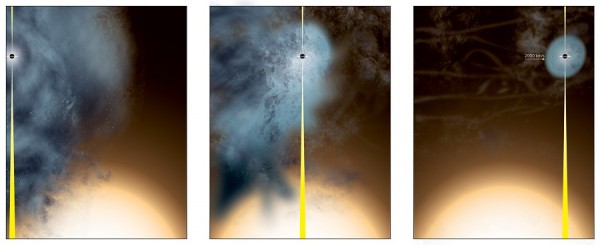By Ana Verayo, | November 07, 2016

An artist's conception of how the "nearly naked" supermassive black hole originated. (Bill Saxton/NRAO/AUI/NSF)
In the core of galaxies lie mysterious supermassive black holes that can suck galactic material such as gas, dust and even light and sound. Now, astronomers have discovered for the first time, a supermassive black hole which is so devoid of such galactic material that it is considered almost "naked."
Like Us on Facebook
Scientists from the National Radio Astronomy Observatory identified this nearly naked black hole as the galaxy surrounding it is being stripped away of material by another larger neighboring galaxy.
Now, this black hole's remaining galactic material only measures 3,000 light years, compared to our very own Milky Wa which is estimated to be 100,000 light years across.
Astronomers reveal what is going inside this imminent colossal cosmic collision, as the black hole is being unmasked of its galactic blanket and is also trying to escape from these two galaxies, at 2,000 miles per second.
Usually, as two galaxies collide and merge, the black holes inside their cores collide and also merge.
According to NRAO scientist, James Condon, at first, they were searching for orbiting pairs of supermassive black holes with one that would be off center from its galaxy, which is a telltale sign of a previous galaxy merger. However, this "naked" black hole was detected escaping from a larger galaxy and leaving behind it this cosmic debris.
The discovery was made with the help of the powerful radio telescope known as the Very Long Baseline Array at the National Science Foundation. Astronomers call this naked black hole B3 1715+425. It was identified inside the ZwCl 8193 galaxy cluster.
Nearly Naked Black Hole from NRAO Outreach on Vimeo.
Condon said that the VLBA data obtained was of very high quality. The researchers collected information from these supermassive black holes in "extremely good precision."
Astronomers predict that this naked black hole will have a bleak future ahead of it since its surrounding galaxy is continuously being stripped off of its stellar material and will eventually stop giving birth to stars.
This supermassive black hole will soon disappear into oblivion, but astronomers suggest that there are still many cosmic anomalies similar to B3 1715+425 which could soon to be discovered.
This new study was published in the Astrophysical Journal.
-
Use of Coronavirus Pandemic Drones Raises Privacy Concerns: Drones Spread Fear, Local Officials Say

-
Coronavirus Hampers The Delivery Of Lockheed Martin F-35 Stealth Fighters For 2020

-
Instagram Speeds Up Plans to Add Account Memorialization Feature Due to COVID-19 Deaths

-
NASA: Perseverance Plans to Bring 'Mars Rock' to Earth in 2031

-
600 Dead And 3,000 In The Hospital as Iranians Believed Drinking High-Concentrations of Alcohol Can Cure The Coronavirus

-
600 Dead And 3,000 In The Hospital as Iranians Believed Drinking High-Concentrations of Alcohol Can Cure The Coronavirus

-
COVID-19: Doctors, Nurses Use Virtual Reality to Learn New Skills in Treating Coronavirus Patients







